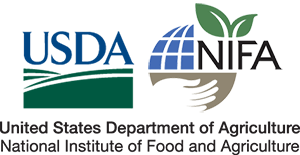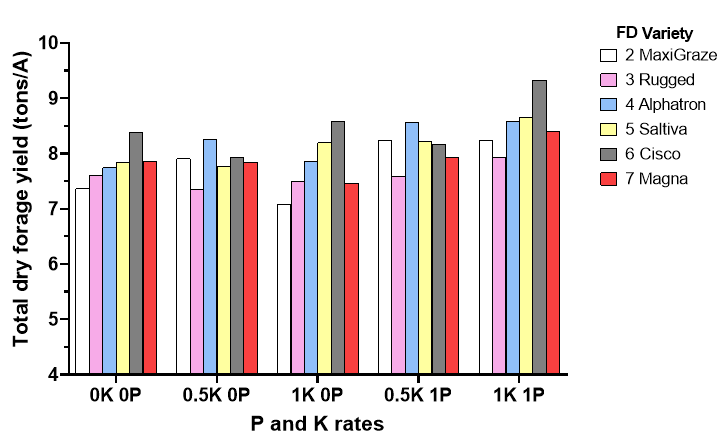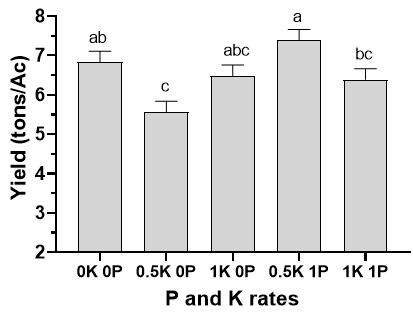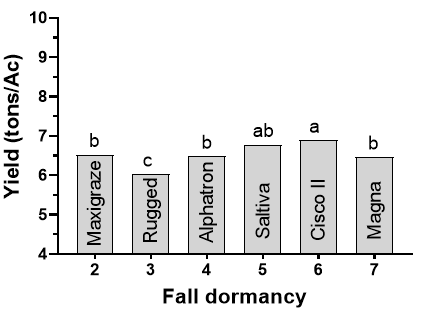Phosphorus and Potassium Fertilization of Dormant to Semi-Dormant Alfalfa
Link to Phosphorus and Potassium Fertilization of Dormant to Semi-Dormant Alfalfa Printable PDF
Objective:
To evaluate the performance of alfalfa varieties with differing P and K fertility in rainfed and irrigated environments
Personnel: MFAC
J.A. Torrion, Eeusha Nafi, Daniel Porter 
Summary:
This study was on its third year of alfalfa establishment. The study received 6.4 inches of rainfall during the 2021 growing season. The irrigated environment was irrigated with a total of 10.6 inches. Cultural practices are detailed in Table 1.
For some treatments, P and K nutrients were reapplied (Table 2) as these treatments showed some deficiency and the soil nutrient concentration in the soil reached below 8 and 100 ppm, respectively. This was to ensure that the level of nutrients on these rates were maintained throughout.
Under irrigation, there was no yield response with fertilizer application rates. However, there was an interaction with fertilizer rates and variety (Figure 1). When K nutrient level was at the full rate, regardless of P levels, the fall dormancy, FD 6 (Cisco II), had a significantly higher yield. At the 0.5K rate, regardless of P level, the FD 4 (Alphatron) responded the most. In addition, at the no added P and K (control), Cisco II had the highest yield. For three years, the FD 6 (Cisco II) consistently showed yield advantage under irrigation for most of the nutrient rates.
Under rainfed, the 0.5K 1P rate showed the highest yield this year. Increasing K rate (from 0.5K to 1K) leaving P at 0, also increased yield (Figure 2). The full rate (1K 1P) treatment did not show superiority in yield. We suspect that it is related to alfalfa’s luxurious consumption of nutrients, when available, but of no yield advantage. In the first year of establishment (2019), the site had a substantial P and K residual nutrient (Table 1) – which seem to sustain the rainfed unfertilized control treatment. Alfalfa also has deep and extensive root system which potentially benefited available nutrients deeper in the soil. Lastly, only during the 3rd year of establishment (2021) of which Cisco II (FD6) and Saltiva (FD 5) both showed higher yields whereas Rugged (FD 3) had the lowest yield (Figure 3). In the prior years (2019 and 2020), there was no yield advantage in the choice of FD under rainfed condition.
The nutrient level and fall dormancy impacts to forage quality is pending due to testing delays.
Table 1. Management Information
| Seeding date: | 5/22/2019 | Field Location: | R8 |
| Julian date: | 142 | Harvest date: | 6/24 -7/1 (1st Cut), 7/19-7/27 (2nd Cut), 8/31-9/21 (3rd Cut) |
| Seeding rate: | 30 plants/ft2 | Julian date: | 175-182, 200-208, 243-264 |
| Previous crop: | Barley | Soil type: | Fine sandy loam |
| Herbicide: | Raptor (6/18/19) | Tillage: | Conventional |
| Insecticide: | None | Soil residual nutrient (NO3-, P, K lbs/A): | 50-16-176 (Fall, 2018) |
| Fungicide: | None | ||
| Seed Treatment: | Apron XL, others pre-treated upon arrival | Nutrient fertilizer applied (N,P2O5, K2O lbs/A): | Varied according to P and K rates. Reapplied in 2021 (Table 2) |
| Inoculant: | Verdesian PreVail |
Table 2. Nutrient reapplications in both rainfed and irrigated environments.
| K2O rates | P205 rates | First year (2019) application | Third year (2021) reapplication | |||
| ---------------------------------lbs/A-------------------------------------------- | ||||||
| K2O | P2O5 | N | K2O | P2O5 | ||
| 0 | 0 | 0 | 0 | 8.5 | 0 | 0 |
| 0.5 | 0 | 85 | 0 | 8.5 | 0 | 0 |
| 1 | 0 | 170 | 0 | 8.5 | 170 | 0 |
| 0.5 | 1 | 85 | 40 | 8.5 | 85 | 100 |
| 1 | 1 | 170 | 40 | 8.5 | 170 | 0 |

Figure 1. Variety x fertilizer rates interaction under irrigated condition. The actual P and K rates in lbs/A is detailed in Table 2.

Figure 2. P and K rate effects on rainfed yields in 2021 (3rd year).

Figure 3. Varietal effect with various dormancy on rainfed yields in 2021 (3rd year)
